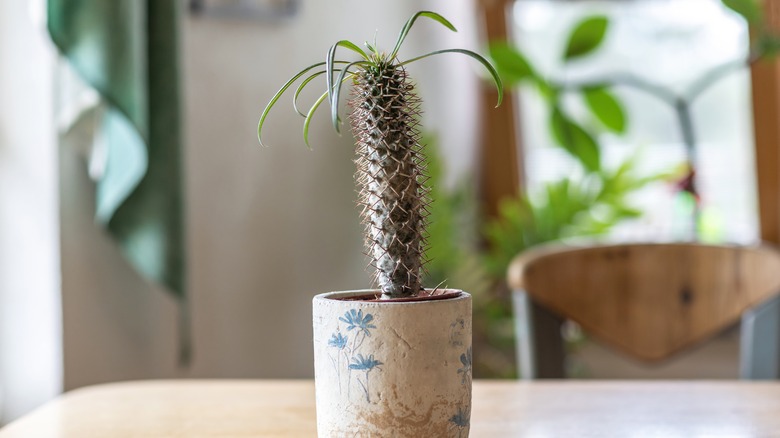The Low-Maintenance Houseplant That'll Beautifully Elevate Your Home's Interior
Native to the island of Madagascar, Madagascar palms are actually succulent plants that look like palm trees with their build of thick trunks and clustered rosettes of leaves. When they bloom, they produce striking and showy flowers from their top in various shades of white, yellow, or pink. With their unique appearance combined with their low-maintenance nature, Madagascar palms make unique and attractive ornamental plants for any home's interior.
Madagascar palms are popular in various parts of the world and make a good addition to a garden for their height, tropical look, drought tolerance, and general resistance to diseases. They are specifically great in a plant collection as anchors or focal points and can be paired with plants with similar needs like agave or crown of thorns. While they can do without a lot of attention, it helps a lot when they are in ideal environments, which includes USDA hardiness zones 9b to 10.
Things to note with Madagascar palms
Madagascar palms are often grown in pots indoors or in dry gardens outdoors. They can grow very tall, around 6 feet inside and up to 16 feet outside, so they need adequate space. They also grow slowly and can take many years to reach their full size, another characteristic that makes them suitable as long-term houseplants or garden plants.
Another low-maintenance characteristic of this plant is that they don't need a lot of pruning. You can prune to get rid of dead or damaged parts or if you want the plant in a certain form. This is useful if you keep them in an area with limited space. Unfortunately, Madagascar palms are toxic to both humans and pets. They can cause problems when ingested by pets and can poison humans who come in contact with the sap and sharp spikes. Always use gardening gloves when handling this plant, and keep them out of the way of any animals.
How to care for this low-maintenance houseplant
Due to their climate of origin, they thrive best when planted in bright and warm areas and are fine with dryness. As outdoor plants, they should be in areas where the temperature is above 50 degrees Fahrenheit and should be moved inside if the outdoor temperature drops below this. As indoor plants, give Madagascar palms bright, indirect light by placing them at a window that faces west or south. Note that they might lean towards the light so you need to rotate them when this happens so their trunk stays straight.
They can be watered only when their soil is fully dry and should only be made moist. They should be in pots or containers that have a drainage hole and need porous, well-draining soil. Fertilize when you spot new growth, typically in spring. While they might lose their leaves in winter, don't worry as they will grow new ones if you keep them in a lit area with dry soil.


